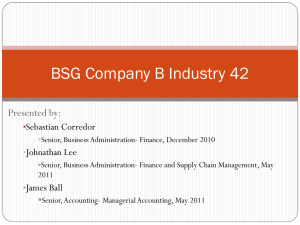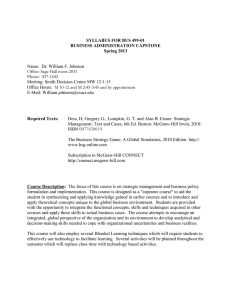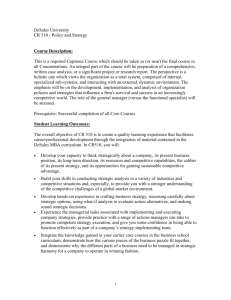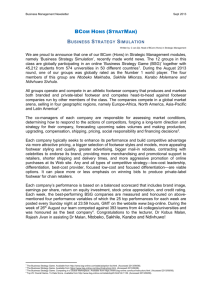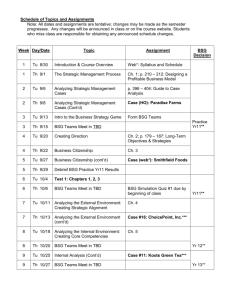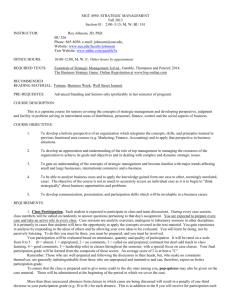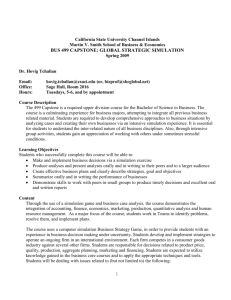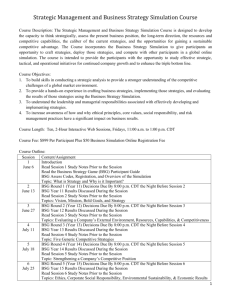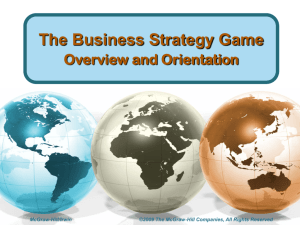Company B Industry 42 presentation
advertisement
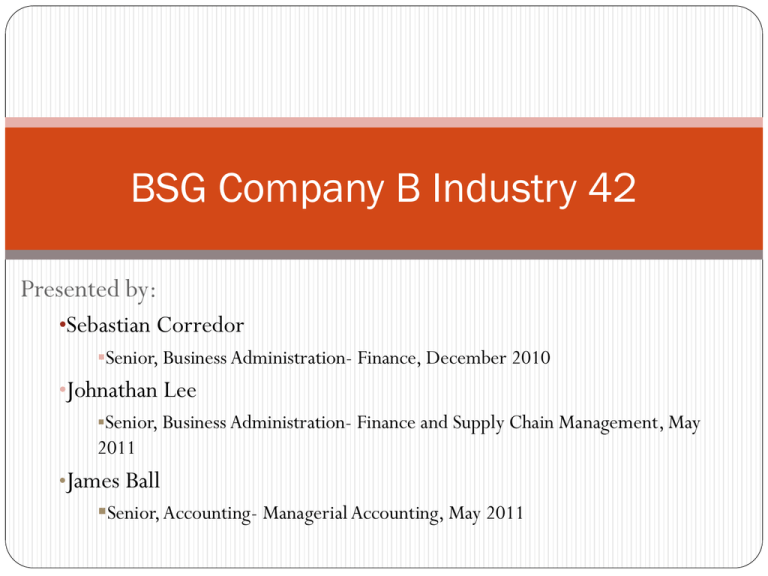
BSG Company B Industry 42 Presented by: •Sebastian Corredor Senior, Business Administration- Finance, December 2010 •Johnathan Lee Senior, Business Administration- Finance and Supply Chain Management, May 2011 •James Ball Senior, Accounting- Managerial Accounting, May 2011 5 Forces Analysis, Industry 42 COMPETITIVE FORCES LEVEL OF COMPETITION Years 11-14 1) SUPPLIERS HIGH: 52.8% superior materials usage thus prices increased 5.6% over the price base. 2) BUYERS HIGH: 7 different sellers -Most sales and revenues from wholesale segment -Switching costs are low 3) SUBSTITUTES LOW: No evidence customers will switch to other products on other industries. 4) RIVALRY MODERATE: only one competitor roughly equal in size (Co. A) -Industry has high rate of sales growth -Most sales from Wholesale segment -Even at full overtime production, capacity is shy to meet future demand 5) THREAT OF ENTRY LOW: No evidence that new companies will enter market. -Industry 42 distributed among companies A, B, C, D, E, F and G 5 Forces, New Entry, Industry 42 Summary: Suppliers: HIGH Buyers: HIGH Substitutes: LOW Rivalry: MODERATE Threat of Entry: LOW Because there are a total of TWO low forces, expected profitability of a new entrant would be ABOUT EQUAL to average cost of capital. BSG Strategic Group Map This strategic position represents the North America region in year 14. Key Success Factors From Footwear Industry: Effective Quality Control Economies of Scope Establishment of Brand Names From BSG: S/Q Rating Operational Efficiency Celebrity Appeal •Between the athletic footwear industry and BSG, effective quality control and S/Q rating are similar. Effective quality control benefits the S/Q rating in the simulation. •In addition, Operational Efficiency from BSG will utilize an Economies of Scope appeal from the athletic footwear industry. •Furthermore, Establishment of Brand Names from the footwear industry and Advertising from BSG have similar connections. A major component of brand name recognition arises from celebrity appeal. Strength Assessment Strength Assessment Table • The strength assessment is based on the three BSG key success factors, taken from the North America wholesale segment in year 14 : • S/Q Rating • Model Availability Key Success Factor Company Score Industry Average Strength Assessment Score S/Q Rating 6 5 4 Model Availability 340 241 5 Advertising (thousands) 7100 7357 3 • Advertising • Based on the strength assessment score, management is performing at or above average in all three BSG key success factors. Market Share Growth Trend year 11 year 12 year 13 year 14 North America Europe/Africa Asia/Pacific Latin America 15.9% 16.3% 17.7% 14.5% 16.0% 15.2% 17.5% 14.70% 14.9% 14.9% 17.3% 14.5% 13.6% 14.7% 15.6% 15.2% Data only represents market share for wholesale segment. Analysis shows market share is decreasing on all geographic regions except for Latin America, which has slightly increased. Management should determine the causes for this decline and implement competitive strategies based on key success factors in order to regain lost market share and build a sustainable competitive advantage in all four geographic regions. Wholesale Segment Market Share 18.0% 17.0% 16.0% North America Europe/Africa 15.0% Asia/Pacific Latin America 14.0% 13.0% 12.0% year 11 year 12 year 13 year 14 Financial Performance Trend EPS Year 11 Year 12 Year 13 Year 14 ROE Net Profit* 3.28 19.50% 12.60% 6.18 27.80% 18.30% 4.42 16.50% 13.00% 5.68 19.60% 15.90% *Net Profit as a percent on net revenues. ROE, EPS, and Net Profit were exceptional on year 12. Company B experienced a decline in year 13 but was able to increase them in year 14. As shareholders we would like to see these numbers return to their year 12 levels. Management should determine the causes of the decline from year 12 to 13 to prevent future fluctuation. ROE and Net Profit 30.00% 25.00% 20.00% ROE 15.00% Net Profit 10.00% 5.00% 0.00% Year 11 Year 12 Year 13 Year 14 Earnings per share (EPS) 7 6 5 4 EPS 3 2 1 0 Year 11 Year 12 Year 13 Year 14 Recommendation To create and sustain competitive advantage in relationship with customers we recommend the following: If top management would like to keep the same price in wholesale segment, they should increase advertising, celebrity endorsements, and implement increased quality and features. • To create and sustain competitive advantage in relationship with shareholders we recommend the following: Management should give out more dividends and repurchase stocks in order to increase their earnings per share and stock price. References "Global Footwear Manufacturing: C1321-GL." IBISWorld Industry Report. 24. NCSU Libraries. Web. 14 Oct. 2010. <http://www.ibisworld.com/globalindustry/keyfactors.asp x?indid=500>.
